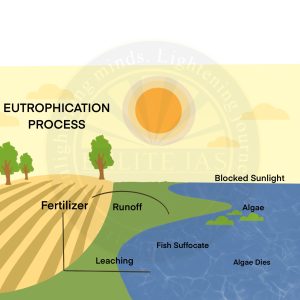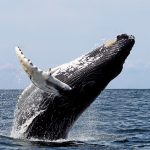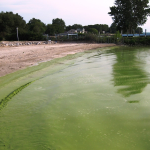What is it?
- Eutrophication refers to the excessive enrichment of water bodies (such as lakes, rivers, and coastal waters) with nutrients, particularly nitrogen and phosphorus, leading to excessive growth of algae and aquatic plants.
Causes
- Natural Causes
- Natural weathering of rocks and soil releasing nutrients into water bodies.
- Decomposition of organic matter over long time scales.
- Anthropogenic Causes
- Agricultural Run-Off: Excessive use of chemical fertilizers and manure leads to nitrate and phosphate run-off into lakes and rivers.
- Domestic Sewage: Untreated or partially treated sewage contains high amounts of nutrients.
- Detergents: Use of phosphate-based detergents adds to the nutrient load.
- Industrial Effluents: Discharge from certain industries, like food processing and paper mills, contains high nutrient levels.
- Aquaculture: Excess feed and fish excreta increase nutrient content.
- Urban Run-Off: Stormwater carries fertilizers, detergents, and organic matter from urban areas.
- Atmospheric Deposition: Nitrogen compounds from industrial and vehicular emissions deposited via rain.
Process

Effects
- Rapid algal growth or algal blooms (e.g., blue-green algae).
- Depletion of dissolved oxygen leading to fish kills.
- Loss of biodiversity and disruption of aquatic food chains.
- Production of toxins harmful to humans and animals.
- Reduced recreational and aesthetic value of water bodies.
Measures To Control
- Promoting use of organic and slow-release fertilizers in agriculture.
- Proper treatment of domestic and industrial wastewater before discharge.
- Regulation and reduction of phosphate content in detergents.
- Buffer zones and constructed wetlands to filter run-off.
- Promoting sustainable aquaculture practices.
- Strengthening environmental regulations and monitoring.


